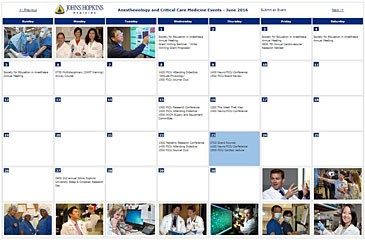 Dr. J. Ricardo Carhuapoma’s overall research interests include three areas: (1) the role of pharmacologic neuroprotection of perihematoma tissue following intracerebral hemorrhage (ICH); (2) the different hemodynamic and metabolic aspects of neuronal blood flow and metabolism under physiologic conditions and after acute brain injury, as well as their significance in neurologic outcome; and (3) the use of advanced MRI techniques in the study and understanding of ongoing neuronal damage after brain injury to design and assess therapies used in neurologic critical care.
Dr. J. Ricardo Carhuapoma’s overall research interests include three areas: (1) the role of pharmacologic neuroprotection of perihematoma tissue following intracerebral hemorrhage (ICH); (2) the different hemodynamic and metabolic aspects of neuronal blood flow and metabolism under physiologic conditions and after acute brain injury, as well as their significance in neurologic outcome; and (3) the use of advanced MRI techniques in the study and understanding of ongoing neuronal damage after brain injury to design and assess therapies used in neurologic critical care.
To investigate these areas, Dr. Carhuapoma is engaged in a number of studies. The first explores the safety and feasibility of thrombolysis with ultrasound in the treatment of ICH and intraventricular hemorrhage (known as the SLEUTH study).
In another study, Dr. Carhuapoma and his colleagues are investigating removal of an ICH with minimally invasive surgery and treatment with recombinant tissue plasminogen activator (rtPA). The goal of this study is to provide novel safety data that will change the way in which ICHs are treated, including previously unavailable data about the safety, efficacy, and pharmacokinetics of rtPA, as well as MIS data regarding the validity and safety of patient selection, quantitation of surgical effectiveness, patient stability, and disease/treatment-related complications. The study results also will provide the first estimates of the relationship between initial disease severity and long-term outcome for ICH. These data are critical to reducing brain injury from the only stroke subtype for which no adequate treatment is available.
In a study supported by the Food & Drug Administration, Dr. Carhuapoma and his colleagues are conducting a multicentered clinical trial of thrombolysis for intraventricular hemorrhage, the results of which will allow for the development of an effective treatment for intraventricular hemorrhage and demonstrate the safety and efficacy of thrombolysis with rtPA for that type of stroke.
Professional Activities
- Neurocritical Care Society
- American Heart Association Stroke Council
- Society of Critical Care Medicine
- Society of Neurosurgical Anesthesia and Critical Care
- American Academy of Neurology
- Neurocritical Care Society
Selected Publications
- Naval NS, Nyquist P, Carhuapoma JR. Intracerebral hemorrhage aspiration and thrombolysis. Special Issue: Update in neurocritical care. J Neurol Sci 261:80–3, 2007.
- Jordan D, Carhuapoma JR. Special Issue: Hypothermia: Comparing technology. Update in neurocritical care. J Neurol Sci 261:35–8, 2007.
- Naval NS, Carhuapoma JR, Mirski MA. Controversies in neurosciences critical care. Anesthesiol Clin 25:675–85, 2007.
- Naval SN, Abdelhak TA, Zeballos P, Urrunaga N, Mirski MA, Carhuapoma JR. Prior statin use reduces mortality in intracerebral hemorrhage. Neurocrit Care 8:6–12, 2008.
- Naval SN, Abdelhak TA, Urrunaga N, Zeballos P, Mirski MA, Carhuapoma JR. An association of prior statin use with decreased perihematoma brain edema. Neurocrit Care 8:13–8, 2008.
- Ramappa P, Thatai D, Coplin W, Gellman S, Carhuapoma JR, Quah R, Atkinson B, Marsh JD. Cardiac troponin-I: A predictor of prognosis in subarachnoid hemorrhage. Neurocrit Care Dec 18, 2007 [Epub ahead of print].
- Carhuapoma JR, Barrett RJ, Keyl PM, Hanley DF, Johnson RR. Stereotactic aspiration-thrombolysis of intracerebral hemorrhage and its impact on perihematoma brain edema. Neurocrit Care 8(3):322–9, 2008.
- Naval NS, Nyquist PA, Carhuapoma JR. Management of spontaneous intracerebral hemorrhage. Neurosurg Clin Am 19(3):415–23, 2008.
Laboratory Members/Key Associates
Clinical Coordinators
Karen Lane, CMA, CCRP
Faculty
Neeraj Naval, MD
Paul Nyquist, MD, PhD
Daniel F. Hanley, MD
Research Assistants
Andrew Mould
Collaborators
John Lewin, PharmD
